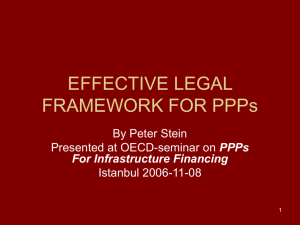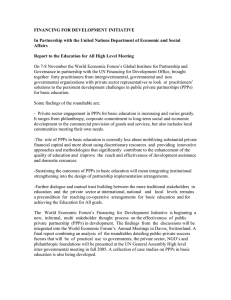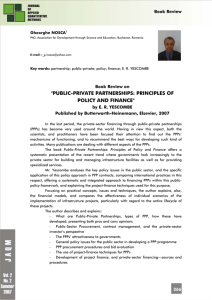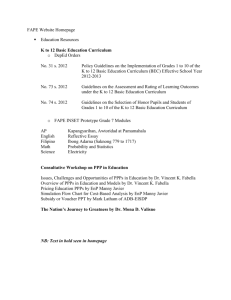Public–private partnerships: Report on progress
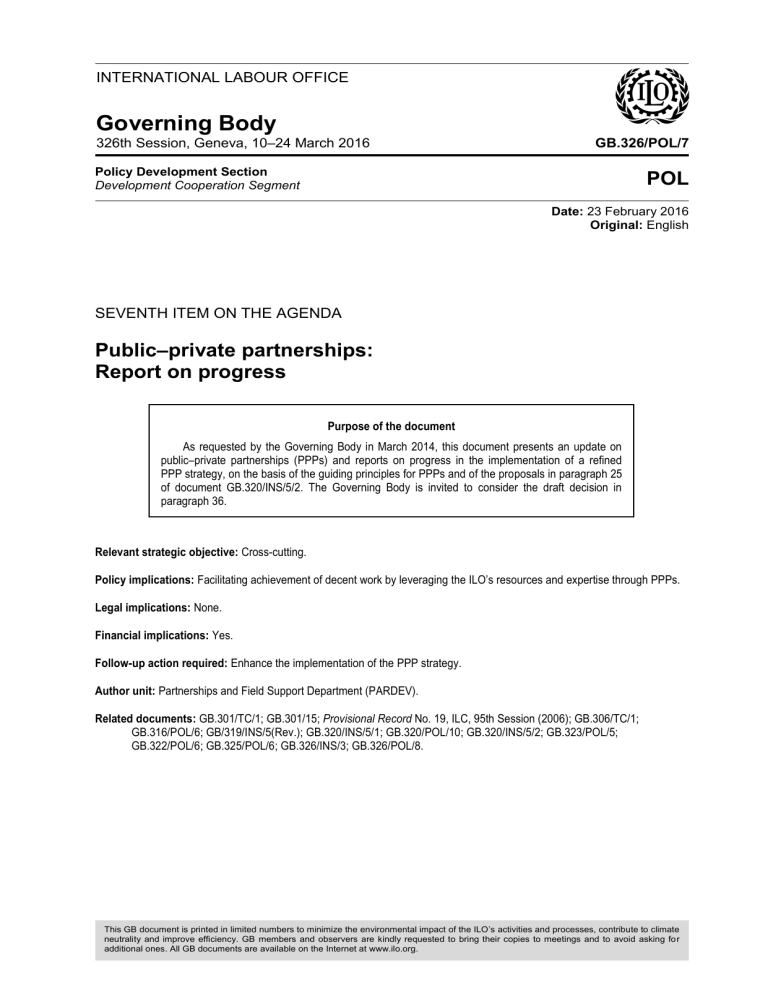
INTERNATIONAL LABOUR OFFICE
Governing Body
326th Session, Geneva, 10 –24 March 2016
Policy Development Section
Development Cooperation Segment
GB.326/POL/7
POL
Date: 23 February 2016
Original: English
SEVENTH ITEM ON THE AGENDA
Public
–private partnerships:
Report on progress
Purpose of the document
As requested by the Governing Body in March 2014, this document presents an update on public–private partnerships (PPPs) and reports on progress in the implementation of a refined
PPP strategy, on the basis of the guiding principles for PPPs and of the proposals in paragraph 25 of document GB.320/INS/5/2. The Governing Body is invited to consider the draft decision in paragraph 36.
Relevant strategic objective: Cross-cutting.
Policy implications: Facilitating achievement of decent work by leveraging the ILO’s resources and expertise through PPPs.
Legal implications: None.
Financial implications: Yes.
Follow-up action required: Enhance the implementation of the PPP strategy.
Author unit: Partnerships and Field Support Department (PARDEV).
Related documents: GB.301/TC/1; GB.301/15; Provisional Record No. 19, ILC, 95th Session (2006); GB.306/TC/1;
GB.316/POL/6; GB/319/INS/5(Rev.); GB.320/INS/5/1; GB.320/POL/10; GB.320/INS/5/2; GB.323/POL/5;
GB.322/POL/6; GB.325/POL/6; GB.326/INS/3; GB.326/POL/8.
This GB document is printed in limited numbers to minimize the environmental impact of the ILO ’s activities and processes, contribute to climate neutrality and improve efficiency. GB members and observers are kindly requested to bring their copies to meetings and to avoid asking for additional ones. All GB documents are available on the Internet at www.ilo.org.
GB.326/POL/7
I. Background
1.
At its 320th Session (March 2014),
1
the Governing Body requested the Office to
2 implement, on the basis of the ILO’s guiding principles for PPPs, a refined PPP strategy.
3
The present paper reports on progress made, and presents key findings and lessons learned for guidance on further opportunities to enhance such implementation, within the framework of the updated ILO Development Cooperation Strategy 2015–17
4 adopted in November 2015. It is set against the backdrop of the Addis Ababa Action
Agenda and the 2030 Agenda for Sustainable Development, highlighting the potential of the private sector to advance the sustainable development goals (SDGs) and the importance of multi-stakeholder partnerships. The Programme and Budget for 2016–17 also indicates that the ILO will be working increasingly through PPPs. South–South and triangular cooperation (SSTC) dimensions are relevant to this strategic agenda, and connected to PPPs.
2.
This paper should be read in conjunction with two other documents submitted to the
Governing Body at its present session: the progress report on the implementation of the
Enterprises Initiative,
5
and the proposed modalities to review the Tripartite Declaration of
Principles concerning Multinational Enterprises and Social Policy (MNE Declaration).
6
II. Overview of PPPs
1. Trends in PPPs (2008 –15)
3.
Since 2008, cooperation between the ILO and the private sector has steadily increased, spreading through most of the ILO’s areas of work. In 2008, PPPs focused on five areas of the ILO’s programme and budget (skills development, entrepreneurship, social dialogue, better work and child labour). In January 2016, they had expanded to 17 different areas, with a particular increase in PPPs addressing international labour standards, social dialogue, industrial relations and wages and governance issues in supply chains. PPPs have also contributed to development cooperation activities in contexts where it is challenging to raise multi-bilateral development aid.
4.
Since 2008, the Office has engaged in 251 PPPs and in 2012 additional resources were allocated to promoting and managing them. In 2012–13, the number of PPPs tripled compared to the previous two biennia, from an average of 30 to more than 90 new partnerships. In 2014–15, 93 new partnerships were signed. This increase was mainly due to new development cooperation projects, the new partnership modality under the Better
Work programme, that is, the Buyer Agreement, the newly established Child Labour
Platform (CLP), and the ILO Global Business and Disability Network. Twelve partners
1
GB.320/INS/5/2.
2
GB.301/TC/1.
3
GB.320/INS/5/2, para. 25.
4
GB.325/POL/6.
5
GB.326/INS/3.
6
GB.326/POL/8.
GB326-POL_7_[PARDE-160120-1]-En.docx
1
GB.326/POL/7 have been continuously engaged with the ILO since 2008, renewing their collaboration over the years. Approvals under PPPs reached US$27,536,293 in 2014–15, 6 per cent of all extra-budgetary resources (XBTC), compared to $17,840,862 in 2012–13 (3.5 per cent).
This made PPPs the fifth contributor to the ILO’s extra-budgetary funding in 2014–15.
5.
PPPs are one way of promoting engagement in support of the Decent Work Agenda and contributing to the implementation of the MNE Declaration. Of the 251 PPPs, 143 are with companies, which also provide the largest source of funding (53 per cent).
Figure 1. PPP partners by funding (2008–15)
6.
The main areas of cooperation with companies have been child labour and fundamental principles and rights at work (39.3 per cent of funding from companies). The Better Work programme and industrial relations and wages projects follow, with 30.2 per cent of funding. Employment promotion, in particular skills and youth employment, represent
20.6 per cent of funding from companies, followed by social finance, with 6.2 per cent, and specific interventions in support of sustainable enterprises (mostly SMEs), with 3.2 per cent of funding. The main private sectors involved are manufacturing (textile, clothing, leather and footwear, chemicals and pharmaceutical); agriculture, food and forestry (food, drink, tobacco, pulp and paper, cacao, chocolate and hazelnut); private sector services
(financial services, investment and insurance, commerce, media and telecommunications) and energy (oil and gas).
2. Thematic scope
7.
PPPs involve a variety of joint activities, such as the development and implementation of projects, capacity building and training, pooling and exchange of information, campaigning and advocacy, meetings and events, publication and research projects. Many knowledge-related partnerships do not involve financial transactions but produce added value through engagement, information, increased visibility and advocacy of the Decent
Work Agenda. The Office has signed more than 50 PPPs in more than 30 countries with universities, knowledge and research centres, contributing to:
2
GB326-POL_7_[PARDE-160120-1]-En.docx
GB.326/POL/7
■ labour market analysis and statistics, policy advice, good practice reviews and evaluation of policy effectiveness, skills forecasting, recognition systems and development for disadvantaged groups, and contributions to policy, legal and regulatory reforms for the promotion of sustainable enterprises;
■ training, building institutional capacity, protection of youth and migrant workers, prevention of HIV and tuberculosis, and reinforcing the capacities of social security staff, analysts, policy-makers and representatives of tripartite supervisory bodies;
■ capacity building to engage in social dialogue and sectoral interventions in the maritime, construction, agriculture and electronics manufacturing sectors;
■ non-discrimination and research on working conditions.
8.
Table 1 gives an overview of the PPP portfolio by strategic objective. Employment
(45.9 per cent) and standards (26 per cent) had the largest shares. They were also somewhat higher than the corresponding percentages for these strategic objectives from other funding sources in the XBTC portfolio: latest figures for overall XBTC approvals
(excluding PPP) show that for the period 2008–15, employment accounted for 42.9 per cent and standards 22.5 per cent.
Table 1. PPP portfolio by strategic objective (2008–15)
Strategic objective Percentage of PPP funding
45.9
Percentage of all partnerships
35.1 Employment (employment promotion, skills development, youth employment, SMEs and sustainable enterprises, and to social finance and the promotion of disability inclusion)
International labour standards (mostly child labour and fundamental principles at work)
Social dialogue (Better Work; new projects on industrial relations and wages; joint workers’ and employers’ initiatives in the construction, electronics and agricultural sectors)
Social protection (mainly social security systems, HIV and AIDS, occupational safety and health)
Policy coherence, cross-cutting themes
26
23.4
4.6
0.1
25.9
27.1
10
2
3. Capacity building of constituents
9.
The ILO partners with private and non-state actors in joint activities of mutual interest to promote the Decent Work Agenda. Capacity building of constituents is an overarching objective and a key modality for the ILO, and PPPs provide fertile ground for work in this area.
10.
Most PPPs are with companies and focus on standards, social dialogue and employment.
Companies have indicated that they are mostly interested in the creation of an enabling environment for sustainable growth, and that one element of the added value of partnering with the ILO is its ability to facilitate cooperation with governments and social partners.
11.
PPPs have hence enabled the Office to enhance both technical assistance to governments and capacity-building activities for social partners. One example is the ILO’s partnership agreement with Hennes & Mauritz AB (H&M) signed in 2014, which establishes a
GB326-POL_7_[PARDE-160120-1]-En.docx
3
GB.326/POL/7 comprehensive approach focusing on industrial relations and wages. Collaboration began in Bangladesh and Cambodia, and expanded to Ethiopia in 2015. Efforts to further expand it to Myanmar are under way. All country-based interventions include a technical assistance component for governments and specific capacity-building activities for social partners, as a basis for longer term results.
12.
Similarly, PPPs focused on the elimination of child labour have been developed in a variety of sectors such as cacao, hazelnuts and tobacco, in Brazil, Côte d’Ivoire, Ghana,
Malawi, Pakistan and Turkey. The intervention model is based on policy support and technical assistance to governments, as well as capacity development of social partners.
Such PPPs are implemented in the framework of Decent Work Country Programmes, and knowledge development and dissemination of data also contribute to capacity development at sectoral, national and global levels.
7
13.
In 2014, the ILO provided technical assistance to the Government of Pakistan to develop a programme on international labour standards, compliance and reporting in the textile industry. A new PPP established with the Pakistan Textile Exporters’ Association (PTEA) is currently being implemented as part of this wider programme. The PPP has provided further means to contribute to capacity development and provide technical assistance on legislation and practice.
14.
PPPs strengthen the capacity of constituents, which in turn promotes their participation in processes of change. Social partners should therefore play a more proactive role in promoting PPPs that respond to their needs. This requires constant coordination and engagement with the Bureau for Employers’ Activities (ACT/EMP) and the Bureau for
Workers’ Activities (ACTRAV), and support to headquarters and field units to ensure that the guiding principles are followed throughout and that opportunities for joint work within the Office are consolidated.
4. Geographic scope
15.
While the highest concentration of activities covered by PPPs remains in Africa (12.4 per cent of partnerships and 16.8 per cent of funding), there is a steadily growing trend in Asia, both in terms of PPP numbers (12 per cent of partnerships) and funding (10.9 per cent).
This is due to the increased number of PPPs on social dialogue and industrial relations in the region, and to new projects addressing fundamental principles and rights at work.
Europe and Central Asia account for 4.4 per cent of partnerships and 9.8 per cent of funding. The Americas follow in terms of numbers (9.6 per cent) and funding (4.6 per cent), followed by the Arab States (5.6 per cent of all PPPs, 3.4 per cent of funding).
16.
More than half of PPPs (56 per cent) fund interventions that are global in scope with funding (52.4 per cent) mostly redistributed to decentralized interventions, mainly focusing on employment promotion and youth employment. The Global Disability Network, the
Better Work Buyers Agreement, and the CLP fall into this category.
4
7
For a full list of the ILO’s PPPs, see http://www.ilo.org/pardev/partnerships/public-privatepartnerships/WCMS_239786/lang--en/index.htm.
GB326-POL_7_[PARDE-160120-1]-En.docx
Figure 2. PPP funding and numbers by geographical region (2008–15)
GB.326/POL/7
5. The South –South and Triangular Cooperation
(SSTC) dimension of PPPs
17.
As a growing form of partnership, SSTC plays an increasingly important role in the ILO’s
PPPs. Several current PPPs have an SSTC dimension, and cover employment promotion, skills development, sustainable enterprises, HIV and AIDS, workers’ organizations, and child labour. These include:
■ The Spanish Cooperation Agency (AECID) and the ILO, with the International
Organisation of Employers (IOE), the Global Apprenticeship Network (GAN) and the constituents of Morocco, Tunisia, Colombia and Mexico have launched a triangular cooperation initiative to generate decent work for youth through practical work experience. The final goal is to create employment opportunities for young people through PPPs that offer work experience and to improve their employability.
■ Partnerships between the All-China Federation of Trade Unions (ACFTU) and the
ILO resulted in the signing of a SSTC PPP to strengthen the technical capacity of union leaders and expand activities in Asia and the Pacific to develop effective trade union policies and strategies on protecting and promoting fundamental rights of the members; enhance the capacity of trade unions to negotiate and carry out collective bargaining; participate in national development efforts; and other related skills, facilitating communications between ACFTU and trade union organizations outside
China to promote sharing of information and experiences in selected subject areas.
■ The National Service for Industrial Apprenticeship (SENAI) in Brazil recently signed a PPP with the ILO and the Vocational Training Institute of Peru (SENATI), the
German Cooperation Agency (GIZ), the Brazilian Cooperation Agency (ABC) and the Peruvian Agency for International Cooperation (APCI), focused on vocational training. The Office is analysing the intervention model of this triangular arrangement for its replication potential.
GB326-POL_7_[PARDE-160120-1]-En.docx
5
GB.326/POL/7
III. Implementation of the refined PPP strategy: Progress and opportunities
18.
The ILO’s principles and values, the Decent Work Agenda, tripartism and gender equality are key elements for engaging with the ILO, as stated in the guiding principles. New PPPs are rooted in these principles, engaging ILO constituents and building collaboration through mutually beneficial arrangements.
19.
The following sections of this document summarize the implementation of the revised strategy and provide the Office’s proposals for continued enhancement of the ILO’s approach to PPPs.
1. A more focused and proactive approach
20.
The refined PPP strategy adopted in 2014 included greater attention to the identification of emerging needs as a basis for engagement with partners, and appropriate modalities for such engagement, as well as further support to enhance ILO field offices’ capacity in this area of work.
21.
Further efforts are needed to develop PPPs in relevant areas of the programme and budget, based on the guiding principles and leading to real, mutual benefits. PPPs are an integral part of the ILO’s Development Cooperation Strategy for 2015–17,
8
which includes the overarching aim of moving towards greater focus and fewer outcomes in order to concentrate attention on areas with most impact for the largest number of people and in the long-term. The five flagship development cooperation programmes
9
have been designed as multi-partner operations and two of them – Better Work and IPEC+ – already enjoy a large PPP base and have developed intervention models in partnership with the private sector. The Office and constituents can make further efforts to identify emerging needs for engagement under the other three flagship programmes, shaping specific and integrated intervention modalities, tools and packages.
22.
Further efforts to identify emerging needs could involve expanding the number and type of partners who collaborate with the Office in specific areas, possibly with a sectoral approach, and proactively building on existing partnerships towards longer term and wider framework collaboration.
23.
As regards tools and packages facilitating engagement, in 2014–15 the Office adapted PPP modalities to different levels of engagement, promoted wider engagement and enhanced the content and scope of existing engagements. For example:
■ In 2014–15, the CLP introduced a peer review approach among members, facilitated by the Office in a neutral role. The CLP has worked both in a cross-sectoral dimension and through sectoral working groups around concrete actions. It has provided enhanced linkages with national tripartite structures and processes, better linking efforts to nationally owned policies and programmes and furthering constituents’ participation.
8
GB.325/POL/6.
9
Better Work; A revised International Programme on the Elimination of Child and Forced Labour
(IPEC+); Occupational Safety and Health (OSH) Global Action for Prevention; Jobs for Peace and
Resilience; the Social Protection Floor. See: GB.325/POL/7.
6
GB326-POL_7_[PARDE-160120-1]-En.docx
GB.326/POL/7
■ A revised PPP template agreement for members of the ILO Global Business and
Disability Network was developed in 2014. A new Charter
10
was launched in
October 2015, committing signatories to increase their efforts in key areas such as non-discrimination, equal treatment and opportunities, job retention, accessibility, and respect of confidentiality, focusing on all types of disabilities and in particular mental and intellectual disabilities.
■ Innovative PPPs have been developed that match ILO priorities to development partners’ and private sector partners’ policies and programmes.
24.
To further enhance ILO field offices’ capacity to engage in PPPs, direct support and training was provided to ten country offices. The Office also conducted pilot training for
ILO staff in April 2015, mostly for field staff. This experience has served to better identify needs and develop an innovative and modular training package that is available to all ILO staff through the E-campus of the International Training Centre of the ILO in Turin. The training package extensively covers the guiding principles and objectives of PPPs and provides examples, practical exercises and role plays that improve understanding of procedures, consultations and negotiations. Further efforts are needed – both direct support and training.
2. Enhanced representational functions, clearance and review
25.
Targeted efforts have been made to ensure and strengthen the role of employers’ and workers’ organizations. Contacts from enterprises are initially directed to ACT/EMP or, if the contact comes from workers’ organizations, ACTRAV. The Bureaux are responsible for sharing information with each other and with the respective group secretariats and the employers’ and workers’ organizations concerned, and for providing any advice or guidance required.
26.
ACT/EMP and ACTRAV have an active role in the appraisal of partnership proposals.
During this process they liaise and consult with national and international employers’ and workers’ organizations. Specific project advisory committees, including national social partners, have been established to steer planning and monitor implementation within the management structures of new, larger PPP projects.
27.
The appraisal and clearance modality remains the same for all types of PPPs (financial and non-financial, companies, foundations, academia and others). ACT/EMP and ACTRAV have highlighted the importance of a consistent appraisal process across all PPPs. One challenge in making more effective use of the PPP modality is to complete the consultation process in a timely fashion as there is no set deadline for the internal clearance process and it has not always been possible to avoid delays.
3. Coordination and knowledge sharing
28.
The specific nature of PPPs requires enhanced coordination, and has created convergence within the Office. Several technical meetings and dialogues were organized during
2014–15, especially for companies wishing to learn more about the ILO’s views on a range of labour issues. This has brought together different ILO units, promoting internal knowledge sharing and team building. Similarly, the internal appraisal process for PPPs
10
http://www.businessanddisability.org/index.php/en/about-the-network/charter.
GB326-POL_7_[PARDE-160120-1]-En.docx
7
GB.326/POL/7 requires coordinated responses on the ILO’s approach. This often requires working in task teams and exchanging points of view.
29.
More opportunities for enhanced coordination could derive from follow-up on existing partnerships. Realizing this potential would require additional resources for coordination and to enhance knowledge sharing. This could serve to further strengthen the link between development cooperation projects and the work done under existing policy and sectoral dialogues and initiatives, tripartite encounters, and other programmes at the country, regional and global levels.
30.
A number of programmes, and IPEC+ in particular, have developed intervention models with the private sector and constituents in countries that are seeking to address human and labour rights issues, along with objectives relating to higher productivity, sustainability and the development of sustainable labour markets, including through the promotion of youth employment. Lessons learned on integrated approaches, based on knowledge sharing and a coordinated approach, could bring added value through the development of PPPs in a variety of areas.
31.
Think tanks, academia and universities are key partners in light of the ILO’s role as a centre for technical excellence and knowledge in the world of work. Properly documenting such PPPs and studying their added value, not only for knowledge sharing but also for advocacy, could inform a specific partnership development strategy.
4. Strategic monitoring of progress
32.
In 2014, the delivery rate of PPPs was 87 per cent, above the average for the overall development cooperation portfolio (79.8 per cent). This can be partly explained by the nature of the partnership modality and the monitoring structures of all the major PPPs, which involve tripartite participation and close consultation with the partners. In addition, the Office allocated staff resources for the management of the overall PPP portfolio providing constant internal monitoring on delivery, and timely reporting on implementation.
33.
These efforts have enabled the Office to widen the base of ongoing PPP projects. There are currently 85 active projects, with more projects in the pipeline. The establishment of a joint project review group in two major PPPs, bringing together partners during the implementation of activities, has been a positive experience, as it provides a more strategic review of the partnership. An evaluation of the overall PPP portfolio, or a more in-depth analysis of the value added of PPPs could further this strategic approach.
5. Communication
34.
The first question potential partners ask is whether the ILO can provide concrete examples of successful collaboration and results. To meet this demand, the Office has compiled more than 60 factsheets on PPPs. These reader-friendly, short documents summarize the response established through each intervention, the results achieved, and the benefits of partnering. The public web page on PPPs
11
has been upgraded and a brochure
12
issued.
11
www.ilo.org/ppp.
12
http://www.ilo.org/pardev/partnerships/public-private-partnerships/WCMS_436572.
8
GB326-POL_7_[PARDE-160120-1]-En.docx
GB.326/POL/7
35.
Communication is a continuous effort and involves meetings, discussions, public forums, and initiatives. Major new PPPs always include a communication and advocacy component, under the overall supervision of the ILO. Partners also disseminate results, and the Office is endeavouring to maximize the use of that potential as well as to monitor and check that messages are in line with ILO principles and values.
Draft decision
36.
The Governing Body requests the Office to:
(a) continue the implementation of the refined PPP strategy, taking into account the guidance provided by the Governing Body on the proposals for improvement;
(b) conduct an independent evaluation of PPPs, their value added and the intervention models used, in line with the workplan set for ILO evaluations.
GB326-POL_7_[PARDE-160120-1]-En.docx
9
